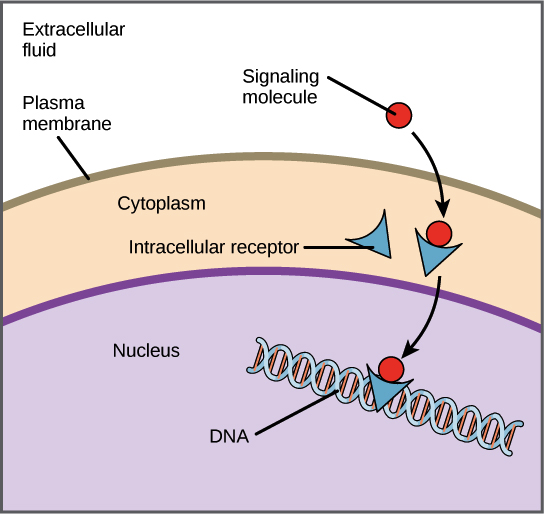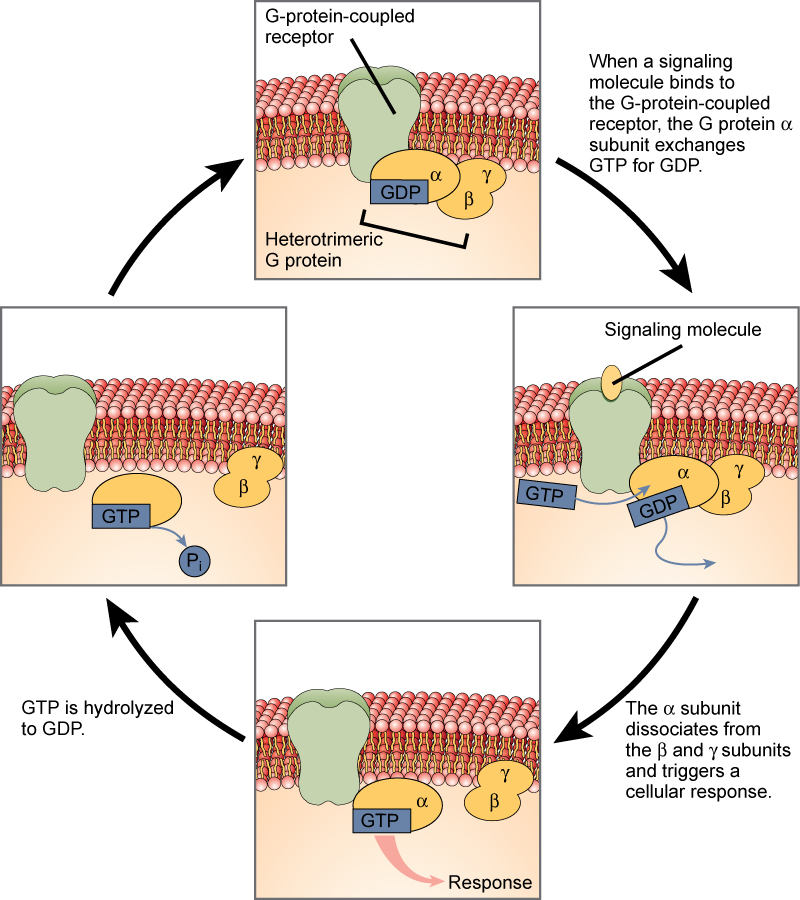Signal Transduction Study Guide
Introduction:
Like any remote-controlled toy, cells have an antenna that receives incoming signals from a controller. Signal transduction is how the external signal transforms to an internal cellular response. The signal transduction pathway involves a three-step process.
Signal transduction
The process begins with the receptor receiving a signal. It may be a peptide, a small chemical, or protein. When received, the intermembrane receipt protein domain catalyzes a reaction and starts the cell signaling pathways.
The signal transduction pathway is diverse and specific to each receptor protein and the signal that it will receive. It involves protein modification and the process of phosphorylation. It also uses various secondary messengers, thereby, amplifying and relaying the signal to various cell parts.
The cellular response is the ultimate conclusion of the transduction signal pathway. It varies depending on the signal received.
Signal transduction – A description
Cell signaling overview
The cell signal occurs in three stages:
- Reception is when the cell detects a signaling molecule from the cell’s extracellular matrix. This signal then binds to its specific receptor and causes a change in the protein receptor shape
- Transduction is the process initiated by the binding of the signaling molecule to the receptor. The signaling system has to be responsive to any small chemical signal concentration and it should act quickly. This is why cells make use of second messengers (such as cyclic AMP) to relay and amplify the intracellular signals.
- The signal transduction steps involve adding or removing the phosphate group that results in protein activation. The protein kinases are the enzymes that transfer the phosphate group from the ATP to a protein via a phosphorylation cascade.
- The final step is a specific cellular response such as gene expression. Cell signaling eventually causes the regulation of one or more cellular activities. It could regulate the closing and opening of ion channels in the plasma membrane, promote cell metabolism like glycogen breakdown and cause some major cellular events like programmed cell death or cell division.
The Intracellular Receptor
The intracellular receptors are present in the cell. These can be in the cytoplasm or the nucleus of the target cell. The chemical messengers which are small or hydrophobic will pass through the plasma membrane without any kind of assistance. They then bond together with the intracellular receptors. Once it is activated and bonded by a signal molecule then the activated receptor initiates a cellular reply. This could be something like a gene expression change.
Cell Surface Receptors
Cell Surface Receptors are transmembrane proteins that are embedded in the plasma membrane which play a crucial role in maintaining communication between the internal processes in the cell and various kinds of extracellular signals. Each cell-surface receptor has three main components: an external ligand-binding domain, a hydrophobic membrane-spanning region, and an intracellular domain inside the cell. There are three types of cell surface receptors: ion channel-linked receptors, G-protein-linked receptors, and enzyme-linked receptors.
G-protein Coupled Receptors
The G-protein coupled receptors are a diverse and large group of membrane receptors in the eukaryotes. G-protein-linked receptors bind a ligand and activate a membrane protein called G-protein and help in a cell’s response to hormones, neurotransmitters and environmental stimulants. Each GPCR has seven membrane-spanning α-helical segments separated by alternating intracellular and extracellular loop regions.
Conclusion:
- Signal reception takes place at the target cell. This is because the non-targeted cell does not have the required receptor protein.
- The signal transduction process links the signal molecule and the receptor protein to bring about a cellular response.
- The signal transduction pathway is diverse and relies on a variety of mechanisms.
- A huge part of the DNA of an organism is made with the sole aim of producing signal transduction to let them constantly react as per the changes in the environmental conditions.
FAQs:
1. What is signal transduction in cells?
The signal transduction process links the signal molecule and the receptor protein to bring about a cellular response.
2. What are the 3 steps of signal transduction?
Reception, transduction, and response are the three steps in the process of signal transduction.
3. What are the four steps of cell communication via signal transduction?
The four steps of cell communication via signal transduction are as follows:
- Reception
- Transduction
- Response
- Resetting
4. Why is signal transduction important?
Signal transduction helps coordinate the activities of hundreds to trillions of cells especially in multicellular organisms to enable efficient and controlled cell-to-cell communication.
5. What is an example of signal transduction?
Blood glucose homeostasis is an example of signal transduction. Diabetes results from defects in insulin signaling involved in this critical process.
We hope you enjoyed studying this lesson and learned something cool about Signal Transduction! Join our Discord community to get any questions you may have answered and to engage with other students just like you! Don’t forget to download our App to experience our fun VR classrooms – we promise it makes studying much more fun! 😎
Sources:
- Introduction to signal transduction https://bio.libretexts.org/Learning_Objects/Worksheets/Biology_Tutorials/Signal_Transduction Accessed on 31 Dec, 2021
- Signal transduction https://bio.libretexts.org/Bookshelves/Cell_and_Molecular_Biology/Book%3A_Cells_-_Molecules_and_Mechanisms_(Wong)/14%3A_Signal_Transduction/14.01%3A_Introduction_to_Signal_Transduction Accessed on 31 Dec, 2021
- Signal transduction https://www.ncbi.nlm.nih.gov/books/NBK19695/ Accessed on 31 Dec, 2021



